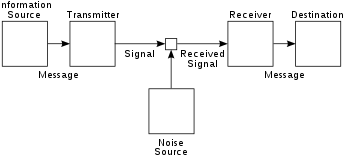A Mathematical Theory Of Communication Shannon Pdf
Article about theory of communication by Claude Shannon
"A Mathematical Theory of Communication" is an article by mathematician Claude E. Shannon published in Bell System Technical Journal in 1948.[1] [2] [3] [4] It was renamed The Mathematical Theory of Communication in the 1949 book of the same name,[5] a small but significant title change after realizing the generality of this work. It became one of the most cited scientific articles and gave rise to the field of information theory.[6]
Publication [edit]
The article was the founding work of the field of information theory. It was later published in 1949 as a book titled The Mathematical Theory of Communication (ISBN 0-252-72546-8), which was published as a paperback in 1963 (ISBN 0-252-72548-4). The book contains an additional article by Warren Weaver, providing an overview of the theory for a more general audience.
Contents [edit]

Shannon's diagram of a general communications system, showing the process by which a message sent becomes the message received (possibly corrupted by noise).
Shannon's article laid out the basic elements of communication:
- An information source that produces a message
- A transmitter that operates on the message to create a signal which can be sent through a channel
- A channel, which is the medium over which the signal, carrying the information that composes the message, is sent
- A receiver, which transforms the signal back into the message intended for delivery
- A destination, which can be a person or a machine, for whom or which the message is intended
It also developed the concepts of information entropy and redundancy, and introduced the term bit (which Shannon credited to John Tukey) as a unit of information. It was also in this paper that the Shannon–Fano coding technique was proposed – a technique developed in conjunction with Robert Fano.
References [edit]
- ^ Shannon, Claude Elwood (July 1948). "A Mathematical Theory of Communication" (PDF). Bell System Technical Journal. 27 (3): 379–423. doi:10.1002/j.1538-7305.1948.tb01338.x. hdl:11858/00-001M-0000-002C-4314-2. Archived from the original (PDF) on 1998-07-15.
The choice of a logarithmic base corresponds to the choice of a unit for measuring information. If the base 2 is used the resulting units may be called binary digits, or more briefly bits, a word suggested by J. W. Tukey.
- ^ Shannon, Claude Elwood (October 1948). "A Mathematical Theory of Communication". Bell System Technical Journal. 27 (4): 623–666. doi:10.1002/j.1538-7305.1948.tb00917.x. hdl:11858/00-001M-0000-002C-4314-2.
- ^ Ash, Robert B. (1966). Information Theory: Tracts in Pure & Applied Mathematics. New York: John Wiley & Sons Inc. ISBN0-470-03445-9.
- ^ Yeung, Raymond W. (2008). "The Science of Information". Information Theory and Network Coding . Springer. pp. 1–4. doi:10.1007/978-0-387-79234-7_1. ISBN978-0-387-79233-0.
- ^ Shannon, Claude Elwood; Weaver, Warren (1949). The Mathematical Theory of Communication (PDF). University of Illinois Press. ISBN0-252-72548-4. Archived from the original (PDF) on 1998-07-15.
- ^ Van Noorden, Richard; Maher, Brendan; Nuzzo, Regina (2014). "The top 100 papers". Nature. 514 (7524): 550–553. doi:10.1038/514550a. PMID 25355343. S2CID 4466906.
External links [edit]
- The full article, hosted by IEEE (requires login)
- (PDF) "A Mathematical Theory of Communication" by C. E. Shannon hosted by the Harvard Mathematics Department, at Harvard University
- Khan Academy video about "A Mathematical Theory of Communication"
A Mathematical Theory Of Communication Shannon Pdf
Source: https://en.wikipedia.org/wiki/A_Mathematical_Theory_of_Communication
Posted by: kittstuaque.blogspot.com

0 Response to "A Mathematical Theory Of Communication Shannon Pdf"
Post a Comment